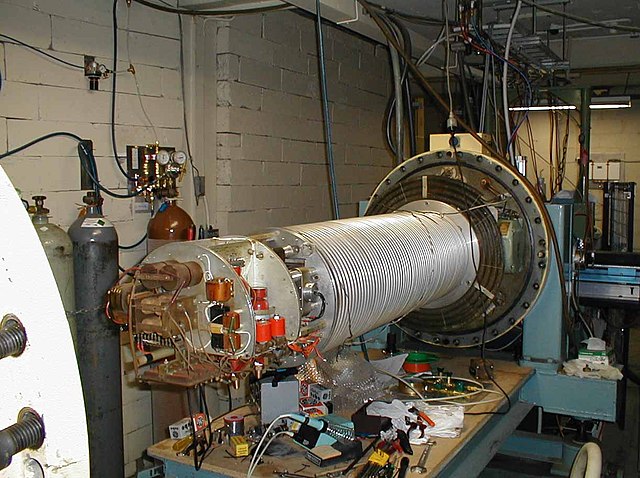A synchrotron is a particular type of cyclic particle accelerator, descended from the cyclotron, in which the accelerating particle beam travels around a fixed closed-loop path. The magnetic field which bends the particle beam into its closed path increases with time during the accelerating process, being synchronized to the increasing kinetic energy of the particles. The synchrotron is one of the first accelerator concepts to enable the construction of large-scale facilities, since bending, beam focusing and acceleration can be separated into different components. The most powerful modern particle accelerators use versions of the synchrotron design. The largest synchrotron-type accelerator, also the largest particle accelerator in the world, is the 27-kilometre-circumference (17 mi) Large Hadron Collider (LHC) near Geneva, Switzerland, built in 2008 by the European Organization for Nuclear Research (CERN). It can accelerate beams of protons to an energy of 7 tera electronvolts (TeV or 1012 eV).

The first synchrotron to use the "racetrack" design with straight sections, a 300 MeV electron synchrotron at University of Michigan in 1949, designed by Dick Crane.
The interior of the Australian Synchrotron facility, a synchrotron light source. Dominating the image is the storage ring, showing a beamline at front right. The storage ring's interior includes a synchrotron and a linac.
Modern industrial-scale synchrotrons can be very large (here, Soleil near Paris)
A particle accelerator is a machine that uses electromagnetic fields to propel charged particles to very high speeds and energies, and to contain them in well-defined beams.
The Tevatron (background circle), a synchrotron collider type particle accelerator at Fermi National Accelerator Laboratory (Fermilab), Batavia, Illinois, USA. Shut down in 2011, until 2007 it was the most powerful particle accelerator in the world, accelerating protons to an energy of over 1 TeV (tera electron volts). Beams of protons and antiprotons, circulating in opposite directions in the rear ring, collided at two magnetically induced intersection points.
Beamlines leading from the Van de Graaff accelerator to various experiments, in the basement of the Jussieu Campus in Paris.
A Cockcroft–Walton generator (Philips, 1937), residing in Science Museum (London).
A 1960s single stage 2 MeV linear Van de Graaff accelerator, here opened for maintenance







